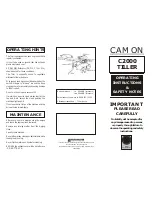
10 - SYSTEM START-UP
10.1 - Checks before system start-up
Before starting up the thermodynamic system, the complete
s y s t e m , i n c l u d i n g t h e t h e r m o d y n a m i c s y s t e m ,
must be verified against the installation drawings, dimensional
drawings, system piping and instrumentation diagrams and the
wiring diagrams.
All measures must be taken to ensure that the pressure and
temperature limits, which are specifically those listed on the
nameplates, are not exceeded during operation, maintenance
and recirculation.
Heat exchange fluid temperatures above the maximum
recommended can lead to an increase in the refrigerant pressure
and can cause a loss of refrigerant due to the relief valve
discharge.
National regulations must be followed during these checks. If
the national regulation does not specify any details, refer to
standard EN 378 as follows:
External visual checks of the installation:
-
Ensure that the unit is charged with refrigerant. Verify on the
unit nameplate that the ‘fluid transported’ is that recommended
for operation, and is not nitrogen.
-
Compare the complete system with the cooling system and
power circuit diagrams.
-
Check that all documents provided by the manufacturer
(dimensional drawings, pipe and instrument diagram (PID),
declarations, etc.) to comply with the regulations are present.
If any documentation is missing, order a replacement.
-
Verify that the environmental safety and protection devices
and arrangements provided by the manufacturer to comply
with the regulations are present and correct.
-
Check that all declarations of conformity for the pressure
vessels, identification plates, and documentation required to
comply with local regulations are present.
-
Verify that access and safety routes are unobstructed.
-
Comply with the instructions and directives to prevent the
deliberate release of refrigerant fluids.
-
Verify the installation of connections.
-
Verify the supports and fixing elements (materials, routing and
connection).
-
Verify the quality of welds and other joints.
-
Check the protection against mechanical damage.
-
Check the protection against heat.
-
Check the protection of moving parts.
-
Verify the accessibility for maintenance or repair and to check
the piping.
-
Verify the status of the valves.
-
Verify the quality of the thermal insulation.
-
Check the condition of 400 V cable insulation.
IMPORTANT: If the compressors are equipped with mounts,
check whether these mounts have clamping mechanisms.
If they do, the clamping mechanisms must be removed
before system start-up. Clamping mechanisms are identified
by red collars and signalled by a label affixed to the
compressor sub-assembly.
10.2 - Commissioning
Always ensure you have read and fully understood the operating
instructions for the units before starting up the unit, and ensure
the following precautions have been taken:
-
Check the heat-transfer fluid circulation pumps, the air
handling equipment, and any other equipment connected to
the exchangers.
-
Refer to these instructions.
-
Refer to the electrical diagram delivered with the unit.
-
Ensure that there is no refrigerant leak.
-
Check that all clamps securing the pipes are correctly
tightened.
-
Check the power supply at the main connection point and the
order of phases.
-
Open the suction shut-off valves on each circuit for the
corresponding units.
-
For units without the factory-fitted hydronic module option,
the installer is responsible for heat protection and the
connections relating to the system pump.
-
Check the operation of the compressor oil crankcase heaters
6 hours before starting up the system.
IMPORTANT:
Commissioning and start-up must be supervised by a qualified
engineer.
-
The system must have a heat load and water flowing in the
exchangers when it is started up and tested.
-
All setpoint adjustments and control tests must be carried out
before the unit is started up.
-
Refer to the Service guide.
Proceed with the unit commissioning.
Make sure all safety devices are operational, and especially that
the high pressure switches are activated and that any alarms
have been cleared.
NOTE:
If the manufacturer's recommendations (system, water
and power connections) are not observed, no claims made under
the warranty will be accepted.
AQUACIAT
POWER
ILD
EN-44
















































